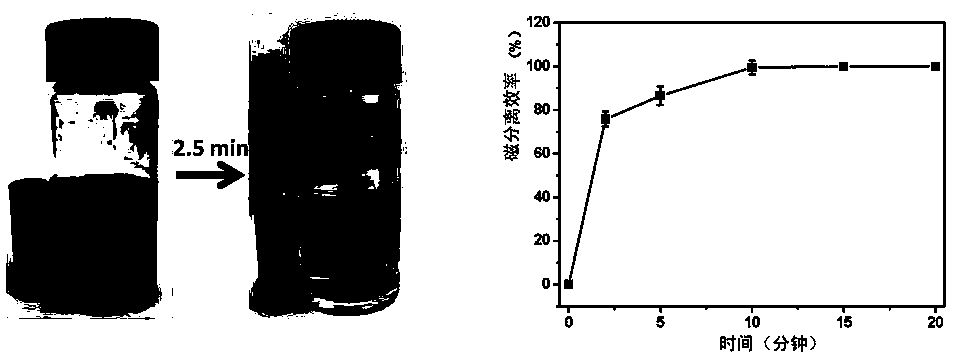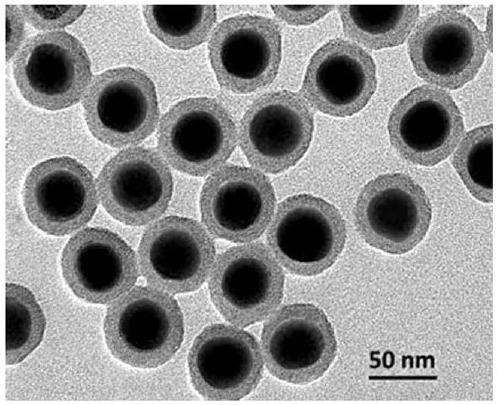Application of a nanoparticle-coupled probe system in the highly sensitive detection of ctdna
A technology of nanoparticles and coupled probes, which is applied in the field of medical bio-nanomaterials, can solve the problems of cumbersome pretreatment, high false positive probability, and high cost, and achieve the effect of high specificity, low false positive probability, and high sensitivity detection
- Summary
- Abstract
- Description
- Claims
- Application Information
AI Technical Summary
Problems solved by technology
Method used
Image
Examples
preparation example Construction
[0055] Regarding the preparation of the magnetic masking agent, the complementary nucleic acid strand DNA of the wild-type gene can be 3 Modification on the surface of magnetic nanoparticles to prepare magnetic masking agent MNP@X-DNA 3 . In one example, masked DNA is prepared by modifying carboxyl groups at the end of the complementary sequence of wild-type ctDNA, for example 3 , through MNP@X surface amino groups and DNA 3 DNA 3 Grafting onto MNP@X surface to prepare magnetic masking agent MNP@X-DNA 3 .
[0056] Next, after the mutant ctDNA is hybridized with the magnetic nanoprobe and the reporter probe added to the detection system, magnetic separation is performed. In the present invention, when the target ctDNA exists, the magnetic nanoprobe and the reporter probe are coupled through ctDNA, and magnetically separated to obtain nanoparticles with reporter elements on the surface of the magnetic nanoparticles; Nanoparticles with no reported elements. Combined with L...
Embodiment 1
[0066] 1. AFe@SiO 2 -DNA 1 , Au-DNA 2 Probe preparation.
[0067] 1. Preparation of amorphous iron (AFe) nanoparticles: Weigh 0.36mmol (175mg) ferric ammonium citrate, 9mmol PVP (Average Mw=55000) and F127 (1.0g) respectively and dissolve them in 40mL anaerobic water, under argon atmosphere Raise the temperature to 70°C, mechanically stir (600rpm) for 60min, and remove the oxygen in the reaction system. 7.5mmol (283g) NaBH 4 Dissolve in 6mL of water, slowly (0.1mL / min) dropwise added to the reaction system to generate a lot of bubbles. After 4 hours, 5 mL of ethanol was added to remove air bubbles, magnetically separated, and the collected amorphous iron nanoparticles were ultrasonically washed three times with ethanol, and dispersed in ethanol for storage.
[0068] figure 1 The TEM spectrum of the amorphous iron (AFe) nanoparticle that this embodiment makes is dispersed in water, by figure 1 It can be seen that the prepared nanoparticles are spherical, have good dispersi...
PUM
| Property | Measurement | Unit |
|---|---|---|
| particle diameter | aaaaa | aaaaa |
| thickness | aaaaa | aaaaa |
| thickness | aaaaa | aaaaa |
Abstract
Description
Claims
Application Information
 Login to View More
Login to View More - R&D
- Intellectual Property
- Life Sciences
- Materials
- Tech Scout
- Unparalleled Data Quality
- Higher Quality Content
- 60% Fewer Hallucinations
Browse by: Latest US Patents, China's latest patents, Technical Efficacy Thesaurus, Application Domain, Technology Topic, Popular Technical Reports.
© 2025 PatSnap. All rights reserved.Legal|Privacy policy|Modern Slavery Act Transparency Statement|Sitemap|About US| Contact US: help@patsnap.com



